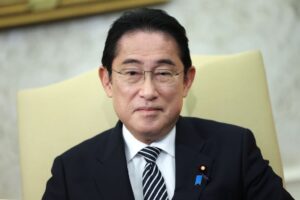NATO Secretary General Jens Stoltenberg plans to visit South Korea during a four-day Indo-Pacific trip from January 29 to February 1, including a stop in Japan. The diplomatic outreach mission follows the participation of the two Pacific nations in the January 20 meeting of the Ukraine Defense Contact Group meeting. Stoltenberg’s trip is intended to solidify ties between NATO and the Seoul and Tokyo governments and show solidarity in a common cause to thwart a common global threat.
A NATO press announcement reported on the secretary general’s official itinerary, explaining:
“In Seoul on 29 and 30 January, the Secretary General will meet with Foreign Minister Park Jin, Minister of National Defense Lee Jong-Sup, and other senior officials. He will also deliver remarks at the CHEY Institute and participate in a wreath-laying ceremony at the National Cemetery. In Tokyo, from January 30 to February 1, the Secretary General will meet with Prime Minister Fumio Kishida and other senior officials. He will also deliver remarks at Keio University.”
 The Korea talks will likely turn to how South Korea can continue to support Ukraine with weapons and other warfighting aid in Kyiv’s struggle against the Russian invasion that began nearly a year ago. The Republic of Korea (ROK) has strongly supported the Ukraine war effort. Through US financing and using the Czech Republic as an intermediary, the ROK has agreed to provide, indirectly, nearly $2.8 billion in arms, according to the Czech daily iDnes. “The weapons will primarily include the South Chiron MANPADS [man-portable, shoulder-fired anti-aircraft missile] …[and] can be used to destroy fixed-wing aircraft, rotary-wing aircraft, helicopters, Unmanned Aerial Vehicles, and cruise missiles from around seven kilometers,” Tanmay Kadam reported in The EurAsian Times. The MANPAD, in its various versions supplied by NATO, the US, and other friends of Ukraine, has been highly effective in bringing down Russian aircraft, cruise missiles, and drones.
The Korea talks will likely turn to how South Korea can continue to support Ukraine with weapons and other warfighting aid in Kyiv’s struggle against the Russian invasion that began nearly a year ago. The Republic of Korea (ROK) has strongly supported the Ukraine war effort. Through US financing and using the Czech Republic as an intermediary, the ROK has agreed to provide, indirectly, nearly $2.8 billion in arms, according to the Czech daily iDnes. “The weapons will primarily include the South Chiron MANPADS [man-portable, shoulder-fired anti-aircraft missile] …[and] can be used to destroy fixed-wing aircraft, rotary-wing aircraft, helicopters, Unmanned Aerial Vehicles, and cruise missiles from around seven kilometers,” Tanmay Kadam reported in The EurAsian Times. The MANPAD, in its various versions supplied by NATO, the US, and other friends of Ukraine, has been highly effective in bringing down Russian aircraft, cruise missiles, and drones.
Additionally, the ROK government is becoming the centerpiece for weapons swaps and arms purchases. For example, Stoltenberg can be expected to support NATO in providing older artillery pieces to Ukraine that will be replaced by more modern South Korean weapons. “And there’s a secret ally in this artillery coalition: South Korea, whose own K-9 self-propelled howitzer is replacing older guns in the arsenals of many NATO countries – and freeing up those guns for onward delivery to Ukraine,” David Axe writing for Forbes explained.
NATO and Indo-Pacific Relationship Mutually Beneficial
The relationship between NATO and Indo-Pacific allies is mutually beneficial. South Korea and Japan have signaled the desire to build close national security bonds with the Alliance. The threatening behavior of China and the willingness of Russia to brutally attack a neighbor, combined with the latest mutual defense pact between Beijing and Moscow, are geopolitical and national defense perils bridging the gap between NATO and the Indo-Pacific regions.
The NATO secretary general can anticipate a friendly, agreeable reception in Seoul. ROK President Yoon Suk-yeol, the first South Korean leader to attend a NATO summit, made his thinking known at the Madrid gathering last June. “As a new structure of competitions and conflicts is taking shape, there is also a movement that denies the universal values that we have been protecting,” President Yoon warned, according to a Reuters report. Yoon was adamant, though not naming Russia and China specifically, the danger was “complex” and “a single country could not solve” the threat.
Japan Onboard with NATO Relationship

Prime Minister Fumio Kishida (Photo by Kevin Dietsch/Getty Images)
Japan’s Prime Minister Fumio Kishida, also a first-time attendee at the NATO summit in Spain, expressed his country’s plans to “update its own partnership document with NATO to boost cooperation in such areas as cyber and maritime security,” Noriyuki Suzuki reported in the Kyodo News. Furthermore, underscoring Japan’s decision to increase its defense posture, the Tokyo government announced a significant increase in its defense spending and longer-range weapons acquisitions. So, the stage is set for substantive talks between General Secretary Stoltenberg and two of the key Indo-Pacific defense players.
To establish assurance of NATO’s security-camaraderie with its Indo-Pacific allies, Stoltenberg needs only to reiterate the firm pledge of unity and shared aims he made in October 2017, when he stated at the Japan National Press Club in Tokyo, “NATO stands in solidarity with its partners in the Asia-Pacific region.” His clear message to China and North Korea was that NATO would join with its Pacific friends against any aggression by either country.
The views expressed are those of the author and not of any other affiliation.
Do you have an opinion about this article? We’d love to hear it! If you send your comments to [email protected], we might even publish your edited remarks in our new feature, LN Readers Speak Out. Remember to include the URL of the article along with your name, city, and state.
Please respect our republishing guidelines. Republication permission does not equal site endorsement. Click here.

